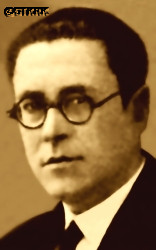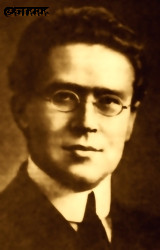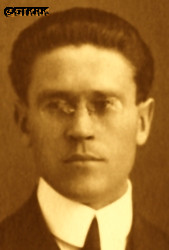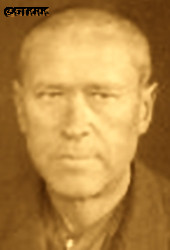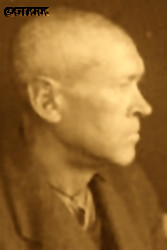Roman Catholic
St Sigismund parish
05-507 Słomczyn
85 Wiślana Str.
Konstancin deanery
Warsaw archdiocese, Poland
full list:
displayClick to display full list

searchClick to search full list by categories
wyświetlKliknij by wyświetlić pełną listę po polsku

szukajKliknij by przeszukać listę wg kategorii po polsku

Martyrology of the clergy — Poland
XX century (1914 – 1989)
personal data
surname
TAMOŠAITIS
forename(s)
Isidore (pl. Izydor)
forename(s)
versions/aliases
Izidorius
function
diocesan priest
creed
Latin (Roman Catholic) Church RCmore on
en.wikipedia.org
[access: 2014.09.21]
diocese / province
Kaunas archdiocesemore on
en.wikipedia.org
[access: 2014.11.14]
academic distinctions
Doctor of Philosophy
nationality
Lithuanian
date and place
of death
06.02.1943

ITL KrasLagGuLAG slave labour camp network
form.: Reshoty station
today: Nizhnyaya Poyma, Krasnoyarsk Krai, Russia
details of death
In 1920‐1940 one of the main ideologist of Lithuanian nationalism.
After German defeat in the World War II started by German and Russian invasion of Poland in 09.1939, after start in 1944/1945 of Russian occupation of Lithuania arrested by the Russians left Kaunas and his university and returned homeland, to Antkalniškiai, taking his library with him.
There prob. on 14.06.1941, during last great deportations perpetrated by the Russians in Russian–occupied from 1939 territories (mainly from Poland but from 1940 also from Baltic countries), arrested by the Russians, sentenced to 10 years of slave labour in Russian concentration camps and sent to Reshoti slave labour concentration camp belonging to ITL KrasLag system of camps.
There perished.
cause of death
extermination
perpetrators
Russians
sites and events
Reshoti (ITL KrasLag)Click to display the description, ITL KrasLagClick to display the description, GulagClick to display the description, Deportations to SiberiaClick to display the description, Ribbentrop‐MolotovClick to display the description, Pius XI's encyclicalsClick to display the description
date and place
of birth
24.08.1889

Antkalniškiaitoday: Jurbarkas eld., Jurbarkas dist., Tauragė Cou., Lithuania
more on
lt.wikipedia.org
[access: 2020.07.31]
alt. dates and places
of birth
12.08.1889
presbyter (holy orders)
ordination
1912

positions held
1922 – 1940
professor — Kaunastoday: Kaunas city dist., Kaunas Cou., Lithuania
more on
en.wikipedia.org
[access: 2022.06.29] ⋄ Universitas Vytauti Magni [i.e. Vytautas Magnus University (from 1930) / University of Lithuania (1922‐1930)] — philosophy, logic and psychology
1937 – 1938
president — Lithuanian Union of Journalists
1929 – 1938
editor — „Vairas” magazine
1930 – 1935
editor — „Eranus” magazine
1927
editor — „Lietuvis” magazine
1920 – 1924
professor — Kaunastoday: Kaunas city dist., Kaunas Cou., Lithuania
more on
en.wikipedia.org
[access: 2022.06.29] ⋄ Theological Seminary ⋄ Samogitia RC diocese
1916 – 1920
PhD student — Fribourgtoday: Fribourg can., Switzerland
more on
en.wikipedia.org
[access: 2021.07.25] ⋄ philosophy, Lat. Universitas Friburgensis (Eng. University of Fribourg)
1912 – 1916
student — Sankt Petersburgtoday: Saint Petersburg city, Russia
more on
en.wikipedia.org
[access: 2020.07.31] ⋄ philosophy and theology, Imperial Roman Catholic Spiritual Academy (1842‐1918)
till 1912
student — Kaunastoday: Kaunas city dist., Kaunas Cou., Lithuania
more on
en.wikipedia.org
[access: 2022.06.29] ⋄ philosophy and theology, Theological Seminary — Samogitian diocese
others related
in death
MIODUSZEWSKIClick to display biography Anthony, ROZUMNYClick to display biography John (Fr January), MILEIKAClick to display biography Alexander
sites and events
descriptions
Reshoti (ITL KrasLag): Part of Russian concentration camp ITL KrasLag — belonging to Russian system of slave labour concentration camps Gulag — in Krasnoyarsk Krai, c. 500 km to the east of Krasnoyarsk, operational in 1940‐1950. Two penal camps — No. 2 and No. 4 — were in existence: for men and women. In both deportees from Russian occupied territories: Poles, Lithuanians, Finns, Kalmuks — in particular prisoners arrested during last big deportation of Poles and Lithuanians from occupied by Russians in 1939‐1941 territories — were held, together with Russian criminal prisoners, worst offenders. Prisoners slaved at forest clearances. In camp for men up to 3,500 prisoners were held captive. Hunger, terror — both from Russian guards and Russian criminal prisoners — caused c. 20 deaths a day. The similar conditions were in women camp — acts of cannibalism were rife. (more on: ru.wikipedia.orgClick to attempt to display webpage
[access: 2018.09.02])
ITL KrasLag: Russian Rus. Исправи́тельно‐Трудово́й Ла́герь (Eng. Corrective Labor Camp) ITL Rus. Красноярский (Eng. Krasnoyarskiy) — concentration and slave forced labor camp (within the Gulag complex) — headquartered in Kansk, and later at the Reshoty station in Nizhnyaya Poyma in the Krasnoyarsk Krai. Founded on 05.02.1938. Prisoners slaved at the forest clearing and wood processing (ski semi‐finished products, production of skis, furniture, railway sleepers), construction of a hydrolysis plant in Kańsk, completion of the construction of railway lines to the ITL AngarLag concentration camp, in agricultural works, in the construction of apartments and roads, production of bricks, etc. At its peak — till the death on 05.03.1953 of Russian socialist leader, Joseph Stalin — c. 31,000 prisoners were held there: e.g. 22,686 (01.01.1942); 23,900 (01.01.1948); 30,007 (01.01.1950); 23,345 (01.01.1951); 26,481 (01.01.1952); 26,611 (01.04.1952); 30,546 (01.01.1953). By 1950 over 100,000 prisoners had passed through it. In the years 1938‐1939 and 1941‐1945, the annual mortality rate was c. 7‐8% of those imprisoned (some were shot). Among the prisoners were many Lithuanians (from 1941) and Volga Germans (from 01.1942). In the second half of the 1940s many political prisoners from Ukraine and Belarus were brought to the camps. Ceased to operate in 1960, though already in 1949‐1950 some of the prisoners were relocated to other concentration camps, to ITL StepLag in Kazachstan among others. (more on: old.memo.ruClick to attempt to display webpage
[access: 2024.04.08])
Gulag: The acronym Gulag comes from the Rus. Главное управление исправительно‐трудовых лагерей и колоний (Eng. Main Board of Correctional Labor Camps). The network of Russian concentration camps for slave labor was formally established by the decision of the highest Russian authorities on 27.06.1929. Control was taken over by the OGPU, the predecessor of the genocidal NKVD (from 1934) and the MGB (from 1946). Individual gulags (camps) were often established in remote, sparsely populated areas, where industrial or transport facilities important for the Russian state were built. They were modeled on the first „great construction of communism”, the White Sea‐Baltic Canal (1931‐1932), and Naftali Frenkel, of Jewish origin, is considered the creator of the system of using forced slave labor within the Gulag. He went down in history as the author of the principle „We have to squeeze everything out of the prisoner in the first three months — then nothing is there for us”. He was to be the creator, according to Alexander Solzhenitsyn, of the so‐called „Boiler system”, i.e. the dependence of food rations on working out a certain percentage of the norm. The term ZEK — prisoner — i.e. Rus. заключенный‐каналоармец (Eng. canal soldier) — was coined in the ITL BelBaltLag managed by him, and was adopted to mean a prisoner in Russian slave labor camps. Up to 12 mln prisoners were held in Gulag camps at one time, i.e. c. 5% of Russia's population. In his book „The Gulag Archipelago”, Solzhenitsyn estimated that c. 60 mln people were killed in the Gulag until 1956. Formally dissolved on 20.01.1960. (more on: en.wikipedia.orgClick to attempt to display webpage
[access: 2024.04.08])
Deportations to Siberia: In 1939‐1941 Russians deported — in four large groups in: 10.02.1940, 13‐14.04.1940, 05‐07.1940, 05‐06.1941 — up to 1 mln of Polish citizens from Russian occupied Poland to Siberia leaving them without any support at the place of exile. Thousands of them perished or never returned. The deportations east, deep into Russia, to Siberia resumed after 1944 when Russians took over Poland. (more on: en.wikipedia.orgClick to attempt to display webpage
[access: 2014.09.21])
Ribbentrop‐Molotov: Genocidal Russian‐German alliance pact between Russian leader Joseph Stalin and German leader Adolf Hitler signed on 23.08.1939 in Moscow by respective foreign ministers, Mr. Vyacheslav Molotov for Russia and Joachim von Ribbentrop for Germany. The pact sanctioned and was the direct cause of joint Russian and German invasion of Poland and the outbreak of the World War II in 09.1939. In a political sense, the pact was an attempt to restore the status quo ante before 1914, with one exception, namely the „commercial” exchange of the so‐called „Kingdom of Poland”, which in 1914 was part of the Russian Empire, fore Eastern Galicia (today's western Ukraine), in 1914 belonging to the Austro‐Hungarian Empire. Galicia, including Lviv, was to be taken over by the Russians, the „Kingdom of Poland” — under the name of the General Governorate — Germany. The resultant „war was one of the greatest calamities and dramas of humanity in history, for two atheistic and anti‐Christian ideologies — national and international socialism — rejected God and His fifth Decalogue commandment: Thou shall not kill!” (Abp Stanislav Gądecki, 01.09.2019). The decisions taken — backed up by the betrayal of the formal allies of Poland, France and Germany, which on 12.09.1939, at a joint conference in Abbeville, decided not to provide aid to attacked Poland and not to take military action against Germany (a clear breach of treaty obligations with Poland) — were on 28.09.1939 slightly altered and made more precise when a treaty on „German‐Russian boundaries and friendship” was agreed by the same murderous signatories. One of its findings was establishment of spheres of influence in Central and Eastern Europe and in consequence IV partition of Poland. In one of its secret annexes agreed, that: „the Signatories will not tolerate on its respective territories any Polish propaganda that affects the territory of the other Side. On their respective territories they will suppress all such propaganda and inform each other of the measures taken to accomplish it”. The agreements resulted in a series of meeting between two genocidal organization representing both sides — German Gestapo and Russian NKVD when coordination of efforts to exterminate Polish intelligentsia and Polish leading classes (in Germany called «Intelligenzaktion», in Russia took the form of Katyń massacres) where discussed. Resulted in deaths of hundreds of thousands of Polish intelligentsia, including thousands of priests presented here, and tens of millions of ordinary people,. The results of this Russian‐German pact lasted till 1989 and are still in evidence even today. (more on: en.wikipedia.orgClick to attempt to display webpage
[access: 2015.09.30])
Pius XI's encyclicals: Facing the creation of two totalitarian systems in Europe, which seemed to compete with each other, though there were more similarities than contradictions between them, Pope Pius XI issued in 03.1937 (within 5 days) two encyclicals. In the „Mit brennender Sorge” (Eng. „With Burning Concern”) published on 14.03.1938, condemned the national socialism prevailing in Germany. The Pope wrote: „Whoever, following the old Germanic‐pre‐Christian beliefs, puts various impersonal fate in the place of a personal God, denies the wisdom of God and Providence […], whoever exalts earthly values: race or nation, or state, or state system, representatives of state power or other fundamental values of human society, […] and makes them the highest standard of all values, including religious ones, and idolizes them, this one […] is far from true faith in God and from a worldview corresponding to such faith”. On 19.03.1937, published „Divini Redemptoris” (Eng. „Divine Redeemer”), in which criticized Russian communism, dialectical materialism and the class struggle theory. The Pope wrote: „Communism deprives man of freedom, and therefore the spiritual basis of all life norms. It deprives the human person of all his dignity and any moral support with which he could resist the onslaught of blind passions […] This is the new gospel that Bolshevik and godless communism preaches as a message of salvation and redemption of humanity”… Pius XI demanded that the established human law be subjected to the natural law of God , recommended the implementation of the ideal of a Christian state and society, and called on Catholics to resist. Two years later, National Socialist Germany and Communist Russia came together and started World War II. (more on: www.vatican.vaClick to attempt to display webpage
[access: 2023.05.28], www.vatican.vaClick to attempt to display webpage
[access: 2023.05.28])
sources
personal:
lt.wikipedia.orgClick to attempt to display webpage
[access: 2018.09.02], www.vle.ltClick to attempt to display webpage
[access: 2018.09.02]
original images:
www.vle.ltClick to attempt to display webpage
[access: 2018.09.02], commons.wikimedia.orgClick to attempt to display webpage
[access: 2018.09.02], www.limis.ltClick to attempt to display webpage
[access: 2018.09.02], www.archyvai.ltClick to attempt to display webpage
[access: 2018.09.02], www.archyvai.ltClick to attempt to display webpage
[access: 2018.09.02], ipn.gov.plClick to attempt to display webpage
[access: 2019.02.02]
LETTER to CUSTODIAN/ADMINISTRATOR
If you have an Email client on your communicator/computer — such as Mozilla Thunderbird, Windows Mail or Microsoft Outlook, described at WikipediaPatrz:
en.wikipedia.org, among others — try the link below, please:
LETTER to CUSTODIAN/ADMINISTRATORClick and try to call your own Email client
If however you do not run such a client or the above link is not active please send an email to the Custodian/Administrator using your account — in your customary email/correspondence engine — at the following address:

giving the following as the subject:
MARTYROLOGY: TAMOŠAITIS Isidore
To return to the biography press below:
 Click to return to biography
Click to return to biography








